Xolotl is an ancient Aztec god associated with several aspects related to death, transformation, and the evening star.
Xolotl was often depicted as a canine figure, such as a dog or a wolf, with distinctive physical features like a skeletal appearance, reversed feet, and an elongated nose.
In Aztec religion, Xolotl guided the sun through its perilous journey into the underworld each evening. He was also seen as a psychopomp, responsible for leading the souls of the deceased to the afterlife.
Table of Contents
Who is Xolotl in Aztec Mythology?
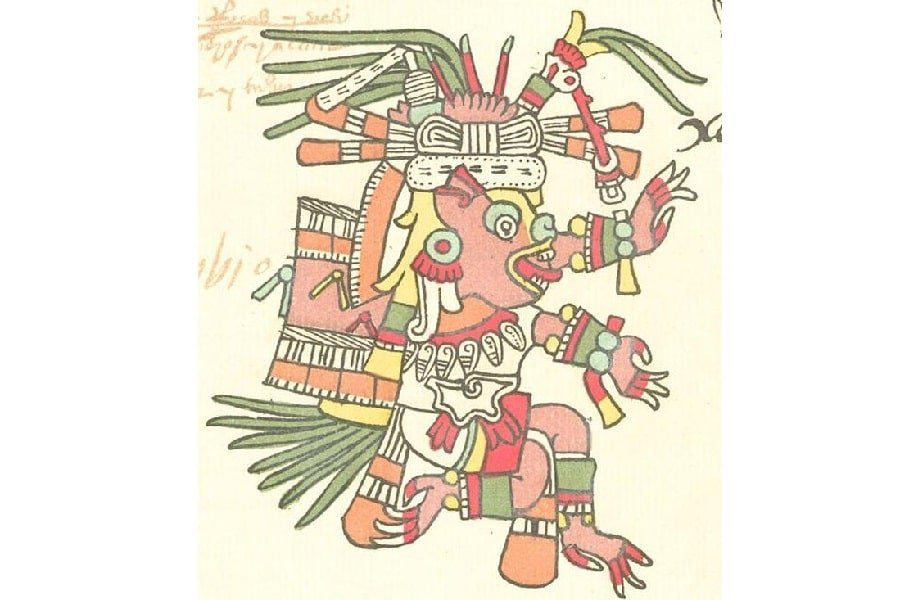
The Aztec god Xolotl has a weird and somewhat understated importance to him within the Aztec pantheon. Whether it is his role as a dog deity, his role as the canine brother of the Aztec god Quetzalcoatl, or his job as the god of monsters, any aspect of Xolotl will tell you a lot about the things that the Aztecs and other ancient civilizations deemed important.
The Name Xolotl
First things first, the meaning of the name Xolotl. It’s a word derived from the Aztec language Nahuatl. There are not a lot of insights that we can derive from the name, since the literal translation would be ‘dog’ or ‘dogs’. Since Xolotl is one of the few deities associated with dogs, there’s no surprise here.
Normally the Aztecs and the Aztec language are quite fancy with their naming, but this time they were very straightforward. Unfortunately, that’s about the only thing that’s straightforward surrounding Xolotl.
The Realms of God Xolotl
The Aztecs had many beliefs about Xolotl. Based on depictions and descriptions, god Xolotl was mainly worshiped as the god of lightning and fire. This, too, gives him the nickname ‘Lord of Fire’.
Another thing that Xolotl is known for is his ability to shape-shift into different beings. Because of this, he is seen as the patron of magicians and sorcerers.
God of Twins
In Aztec mythology, Xolotl also flourishes in his role as the god of twins. Xolotl being the god of twins has to do with, well, his twin brother. That would be Quetzalcoatl, one of the most important gods in Aztec religion. Xolotl allowed Quetzalcoatl to become an important god. In that sense, Xolotl itself is perhaps the more important one of the pair.
Xolotl’s relationship with twins is also reflected in the lightning that Xolotl is known for. The Mayas came up with the relation between lightning and twins, not necessarily the Aztecs.
The Mayas observed that thunder often came in duos, or it had a bright reflection. In both instances, this was interpreted as the thunder showing ‘in pairs’. It’s not a lot, but it is a piece of the puzzle that explains why Xolotl is related to twins in Aztec mythology.
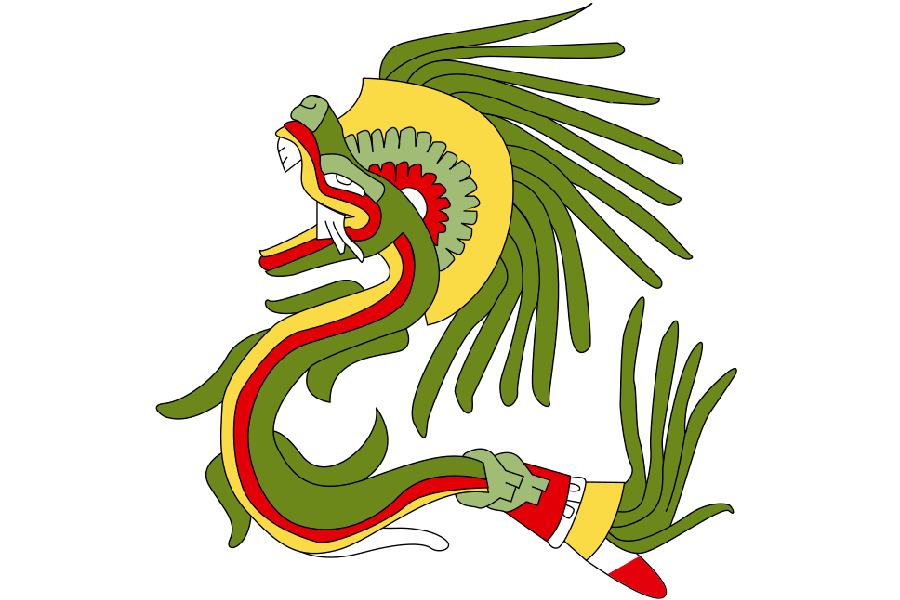
Some Darker Realms
Some other realms that Xolotl is associated with are things like dogs, misfortune, and deformities.
That took a bad turn really fast. Especially when you realize that dogs were a sign of death according to the Aztecs. On the bright side, dogs were a man’s best friend. Still, generally, the god Xolotl is related to many dark and somber realms.
In some sources, he is also the patron god of the Mesoamerican ballgame. The ballgame was a popular sport in the Aztec empire and had a highly ceremonial role. In many instances, the losers of the game were sacrificed to the gods.
Xolotl and the Underworld
One of the positive things that the god Xolotl is related to is its ability to guide the dead in their afterlife through the nine layers of Mictlan (the underworld). Mictlantecuhtli, the god of death, provided the infrastructure to regenerate peacefully, but Xolotl was the one that actually took the people by the hand and showed them a way through Mictlan.
Almost all inhabitants of the Aztec empire were destined for Mictlan. Even the ones that behaved well during their lives. Therefore, the guiding function of Xolotl was of great importance for the Aztecs after they died. Xolotl obtained the role of ‘guide of the dead’ after he allowed the sun to rise for another day. More on that later.
Xolotl and Sickness
Lastly, Aztec god Xolotl was thoroughly related to sickness and deformities. This becomes evident through his depictions at the different temples. A skeletal frame, empty eye sockets, and reverse feet exemplify this association.
While it fitted the idea of deformities, Xolotl has empty eye sockets for a reason. According to the legend, the earliest Aztec gods had to sacrifice themselves to create humanity. Xolotl, being one of the most important gods of death and disease, didn’t like to be sacrificed. The irony.
The god of death cried and cried, hoping it would get him a pass. It didn’t work one bit, but his eye sockets were under quite the pressure after all that crying. His eyes simply couldn’t process his attempt to convince the gods and slowly fell out of their sockets.
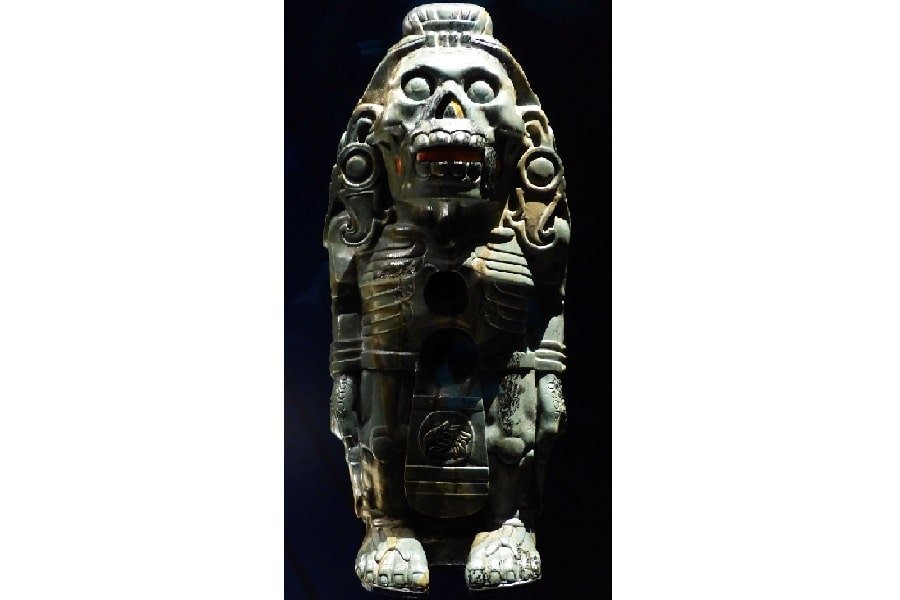
Where Does Xolotl Originate From?
As with many other Aztec gods and goddesses, Xolotl appears in mythological traditions that came way before the Aztecs. Think, for example, about the Maya and Zapotec civilizations.
We can be quite certain that Xolotl originated somewhere in the south of Mesoamerica, a territory mostly occupied by the Mayas. In Popul Vul, one of the most important sources for Maya mythology, there are already references to a dog that is associated with fire, death, storm, and lightning.
Xolotl and the Mayas
Originally, Xolotl was the name used by the Mayas to refer to a large dog that liked to play with lightning and fire. Besides descriptions of Xolotl as a Mayan fire god, the god Quetzalcoatl also makes his appearance. The two were also close in Aztec mythology, and this was most probably influenced by the Mayas.
In Maya mythology, Xolotl is believed to be the breast ornament that is worn by Quetzalcoatl. This would imply that he was seen as the deity of the four cardinal directions, or air more generally.
Xolotl and Quetzalcoatl: A Duality God Conundrum
The Aztec god Xolotl might be a bit confusing for those who have some knowledge of Aztec mythology. That’s because he is considered to be the brother of Quetzalcoatl, which some could interpret as Xolotl being one of the four Tezcatlipocas: the gods of creation. Unfortunately, for those who like things straightforward, that’s not the case. Well, not always.
That brings us to the question: how are Quetzalcoatl and Xolotl related? And in turn, how does Xolotl relate to the four Tezcatlipocas?
Duality in Mesoamerican Culture
Xolotl and Quetzalcoatl should be seen as brothers regardless. Actually, the fact that they are perceived as twins makes the story a bit more accessible, believe it or not.
Twins are a recurring phenomenon in Mesoamerican mythology. They play a central role in the worldview of the Aztecs, as well as in many other Mesoamerican civilizations. It’s a way to represent the two opposites of an entity that are both needed in order to exist as a whole.
For example, what is ‘night’ if we don’t have a clear definition of ‘day’? What is ‘death’ if we don’t have a clear definition of what it means to be ‘alive’?
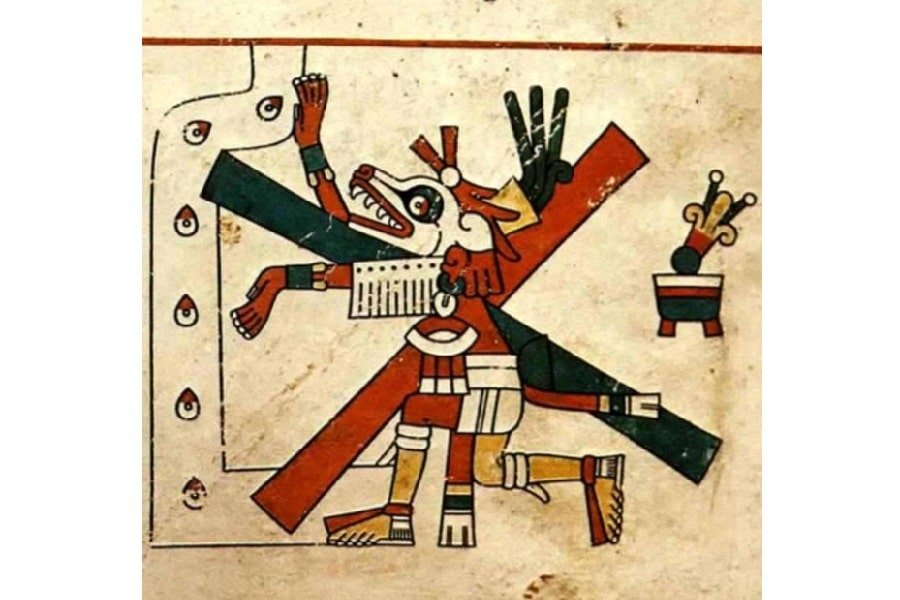
Ometeotl and the Duality of Creation
In Aztec mythology, this emphasis on the ‘duality’ of things arises at the very beginning of life. Before the four gods of creation (the Tezcatlipocas) were even a thing, a god by the name of Ometeotl had to make the universe first.
Ometeotl is both a single god, but also a male-female pair, with Ometeuctli (Lord of Duality) on the one hand and Omecuhuatl (Lady of Duality) on the other. So one entity, but consisting of two gods that represent different aspects. In some instances, they showed up as one. In other instances, they showed up as a pair.
In the case of Ometeotl, one aspect (Lord of Duality, the man) is defined by the other aspect which is represented by the same god (Lady of Duality, the woman). Only because this contradiction exists, both of them have a right to live. This idea resembles quite a lot the philosophy of Yin and Yang and makes you wonder whether the Aztecs might’ve heard of it.
How are Quetzalcoatl and Xolotl Related?
The idea of this duality is also central to the relationship between Quetzalcoatl and Xolotl. They are two different gods, but really they are one entity. The duality of the two gods is related to the twin phases of Venus, a celestial body that was highly regarded within Aztec mythology and Aztec religion.
In relation to Venus, Quetzalcoatl, and Xolotl are known as the morning and evening stars. That’s because Venus is known to appear in the morning for about 236 days, then takes a couple of months off and reappears after 90 days as an evening star. Two hundred and fifty days pass with Venus as the evening star, before it disappears again for 8 days.
Quetzalcoatl and Xolotl represent these two aspects of Venus: at one point a morning star, and at one point an evening star. Quetzalcoatl is regarded to be the morning star, with Xolotl being the evening star. This distinction between day and night would go on to define the whole relationship between Quetzalcoatl and Xolotl.
How Does Xolotl Relate to the Four Tezcatlipocas?
The relationship between Xolotl and the Tezcatlipocas is still a bit tricky. This is mostly because there are competing myths surrounding the creation of the human race, or the Fifth Sun.
In any interpretation, Quetzalcoatl is responsible for the Fifth Sun. The Fifth Sun is the earth in its current form and with its current population.
In most stories about how Quetzalcoatl became the Fifth Sun, he does a lot of things that are well within his range. But, he also does some things that he was normally incapable of doing. One of these things was crossing into the underworld.
Because Quetzalcoatl does things that he wasn’t necessarily capable of, historians believe that he really went to the underworld in a form that was both Quetzalcoatl and Xolotl. That would be either as two gods in the same entity or as two separate gods.
With regards to the Tezcatlipocas, the most logical line of reasoning is that Xolotl is essential to the story of Tezcatlipocas because the Aztec god is also a part of Quetzalcoatl.
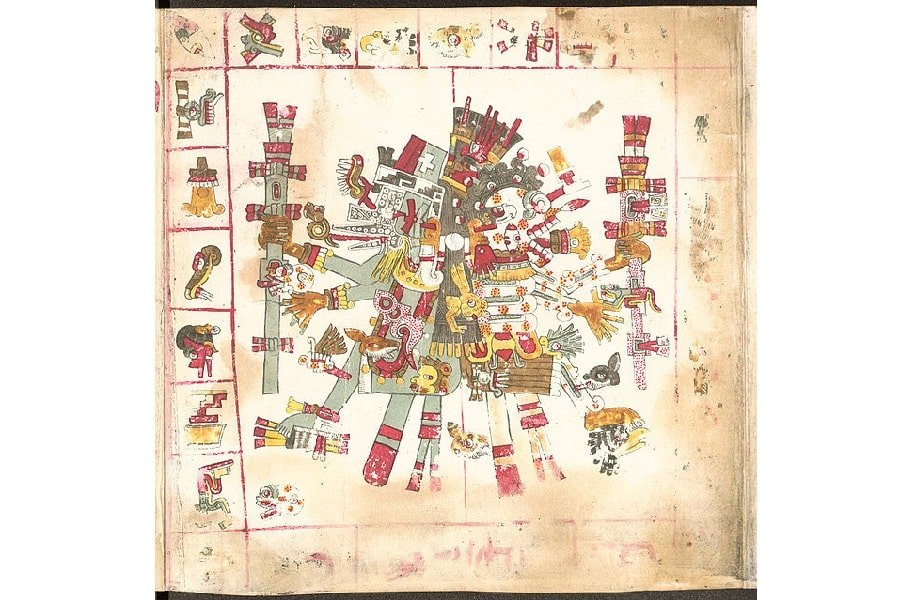
Myths of Xolotl
The brother of Xolotl took all the shine, however. Quite literally. The gods created life by jumping into a fire, and Quetzalcoatl was the first one to volunteer and contribute to the new life for the world. Because of it, he became the new sun. On the other hand, Xolotl had a bit of an identity crisis.
Identity Crisis of Xolotl
First and foremost, this crisis was evident because Xolotl literally cried his eyes out. But, the gods decided that they still wanted to sacrifice him. Even Xolotl knew that a greater effort was needed to avoid being sacrificed. His shape-shifting abilities came in handy.
In order to flee the gods chasing him, he ran into a cornfield and morphed into a corn plant with two canes. Unfortunately, he was soon discovered, which made him run into another field of plants. This time it was a field inhabited by the maguey plant. He became one of them by morphing into two maguey plants.
Again, he was discovered, leading him to resort to the water and turn into an amphibian that later became known as the axolotl. Sadly for Xolotl, he couldn’t stay hidden for too long in his axolotl form. He was tracked down by several other deities and sacrificed after.
Guiding Quetzalcoatl and the Movement of Life
Although he didn’t want it initially, the sacrificing of Xolotl resulted in the movement of life. Quite the accomplishment, which has everything to do with the duality we just discussed.
There he was, shining bright over the earth, the Feathered Serpent, Quetzalcoatl. He did an amazing job giving light to the earth, but the Aztecs knew that it would become a lot scarier and more dangerous if the sun entered the underworld.
According to the Aztec legend, this would happen between sunset and sunrise. During this time, the sun could potentially die.
The god of fire and the night came in handy here. It is believed that Xolotl guided Quetzalcoatl through the night so that he could pop up again the next day, giving light for a new day. Xolotl was able to help in the sun’s rebirth because of his powers to enter and exit the underworld.
This story of moving through the underworld speaks to Xolotl’s abilities as an excellent guide. Later, his role as a guide was extended to the guidance of all dead Aztecs through the underworld.
Movement of Life, the Underworld, and the Ballgame
The importance of guiding Quetzalcoatl is not just as superficial as being a guide. In fact, it plays a big role in Aztec mythology and has many implications in regard to the traditions and ceremonies of the Aztecs.
As we know, Xolotl was the patron god of the ballgame in the Aztec religion. Some academics think that this is because the ballgame is highly uncertain for the players involved. Really, it can result in death, so that’s something you normally want to avoid at all costs. Xolotl was the one that gave a sense of certainty to the game, at least in some regards.
Many depictions of Xolotl see him playing a ballgame against other gods. The fact that the ballgame really was the Xolotl game becomes more evident if you see that every depiction shows the god victorious every time.
Besides, he is depicted with a specific sign known as ‘ollin’. This sign relates to the motion of the rubber ball. Xolotl is also believed to be responsible for the actual action that comes before motion, the playing of the ball more generally.
Lastly, and perhaps the most profoundly, the bouncing of the ball is important. The bouncing ability of the ball, or oscillation, is related to the ability of Xolotl to keep the sun up in the sky after a long night through the underworld. So really, one more job to add to his resume might be the god of rubber balls.

The Creation of Humans
While Quetzalcoatl could now move between day and night, there still wasn’t a lot of life on earth. A big flood, thanks to Tlaloc, the water god, had wiped out all the previous civilizations. Some actions had to be taken before the earth could flourish again. Enter the goddess Citlalinicue, who is believed to have mothered Quetzalcoatl and Xolotl.
READ MORE: Who Invented Water? History of the Water Molecule
She got angry at her sons for just being able to shine above the earth and provide movement of life. She decided they were also responsible for providing the earth with healthy human beings. Since there were none at that point, Quetzalcoatl and Xolotl had to come up with something.
Citlalinicue suggested asking the lord of the underworld, Mictlantechutli, about the possibility to retrieve the bones of the last human beings. With these bones, the emergence of a new civilization was possible. But, they had to be gathered first.
Entering the Underworld
Some stories state that it was Quetzalcoatl alone who went to the underworld to gather the bones, making a new life. However, it’s plausible to assume that Xolotl went with him. Not only because they were potentially two gods epitomized by one entity, but also because Xolotl was already the renowned guard through the underworld.
According to some accounts, Xolotl even descended alone into the underworld to retrieve the bones. Whether it was Quetzalcoatl, Xolotl, or both of them, they weren’t very careful. The bones were dropped after the Aztec god descended silently and tried to steal them from Mictlantecuhtli.
After some booty traps and shape-shifting, the god that descended was able to retrieve the bones successfully and ascended out of Mictlan. When back in the heavens, Quetzalcoatl sacrificed his own blood to the bones. Mixing the bone with the blood brought forth a man and a woman. From here, the earth started to get populated.
The Meaning of Xolotl’s Myths
Up until this point, we have discussed several weird things that relate to Xolotl or Aztec religion more generally. Xolotl literally cried his eyes out, he is one entity together with his twin, and he is the bouncing of the ball. Yet, that’s not all that’s weird about Xolotl. If we look at the meaning of the myths of Xolotl, a whole new weirdness opens up.
The Meaning of the Transformations
It should be emphasized that, in the myth, the Aztec god Xolotl transformed into things that came in pairs: a corn plant with two canes, two maguays, and an axolotl. While it doesn’t seem like it, even the axolotl comes with a certain double life to it.
Xolotl and Axolotl
The double life of the axolotl isn’t very evident at face value. However, axolotls are both aquatic animals and terrestrial animals. This ability is rooted in the axolotls’ ability to regenerate, distinguishing the axolotl as quite the renaissance being.
Early scientists believed that the axolotls were both terrestrial and aquatic animals in the same life, something which the Aztecs potentially also believed. In that sense, the axolotl flows from one being to another, taking the vital energy for life with him.
The relation between the god Xolotl and the axolotl, outside the transformation, is quite evident. Their names really differ by just one letter. The name axolotl literally means ‘water-dog’.
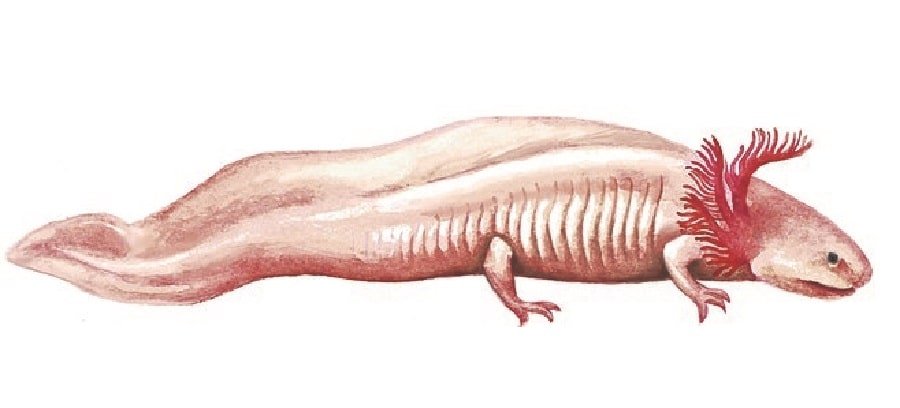
Doubling Transformations, Food, and Life
So, Xolotl only came in doubles. Because of this, people believed that the double form was the only form that Xolotl knew, even if he didn’t want to. The necessity of pairs tells a big part in how Aztecs perceived life: necessarily interdependent and interrelated.
This interrelation is also seen on a grander level. If you look closely and know a bit about the Aztec diet, the things into which Xolotl transformed were all a type of food.
Maize was and still is, the most important crop in Mesoamerica. Maguay is probably the most important plant in the ancient Aztec civilization because it is essential for making pulque. The axolotl, too, was eaten by the Aztecs.
Food is obviously essential to life. Xolotl taking on the form of the different foods also indicates that the god was essential to life. Since he is so closely related to death, it even indicates that death is essential to life. This, too, is reflected in the relationship between Quetzalcoatl and Xolotl.
You might say, isn’t it a stretch to make the link between life and food? Not really, because all of it is interpreted with the grander Aztec worldview in mind. Maize and maguay both have their own gods, so the importance and relation between gods, foods, life, and plants can’t be stressed enough.
Everyday Life, Worship, Arts, and Sculptures
The everyday worship of the Aztec god Xolotl was definitely less intense when compared to the worship of his twin brother. He was still a protector of humans, but only in a very particular way.
While others had big temples dedicated to them, Xolotl was mainly worshiped in Aztec art and with little statues and craft figures. In Aztec art, he was often depicted as a dog-headed man, a skeleton, or a deformed monster with reversed feet.
The art of ancient Mexico included little statues, which were normally considered to be enough for paying homage to the guide of the underworld.
The depictions of dogs also appear in some temples throughout Mesoamerica. Mostly, they take on the position of guards. There a no temples that were exclusively built for the god of thunder, but the dog figures guiding other gods speaks to the importance of the Aztec god Xolotl.
Depictions as a Dog
Dogs eventually became synonymous for Xolotl itself. One dog, in particular, was related to Xolotl. It even wears its name: Xoloitzcuintli. The dog breed is basically a Mexican hairless dog, native to Mesoamerica, and lives on to this day.
In case of death, Aztecs would often sacrifice dogs for this very reason. In a sense, dogs were sacred animals for the Aztecs, albeit quite a negative one. Through ritual sacrifice, the dogs could accompany the dead throughout the underworld. If there wasn’t a dog to be sacrificed, the Aztecs would put a small craft figure in the graves of the ones who died.